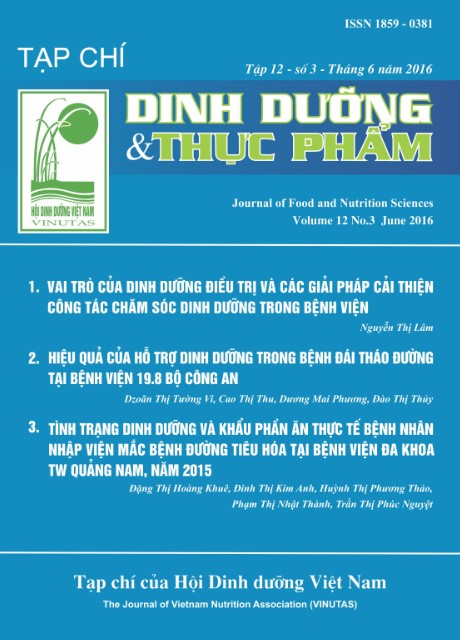OPTIMIZING OF RT-LAMP METHOD FOR FAST DETECTION OF NOROVIRUS IN FOOD
Main Article Content
Abstract
Norovirus, a virus of the Caliciviridae family, is the leading agent of food borne viral gastroenteritis worldwide. The most common foods contaminated by Norovirus are bivalve molluscan and raw vegetables. Among methods to detect Norovirus, RT-LAMP method is one of the most efficient low-costed isothermal amplifying techniques that provide rapid and exact specification. However the LAMP primer set does not always have sufficient specificity to detect all the various type of Norovirus. Therefore this study was conducted to optimize the LAMP primer set and RT-LAMP method. With the purpose of accomplishing this goal, the food samples which were collected from some markets in Hanoi were processed, followed by extraction and purification of viral RNA, then the RT-LAMP reaction was tested to select optimal conditions (concentration of reverse transcriptase enzyme: 2U / reaction; annealing temperature: 63°C; concentration of betaine for GI: 1M, for GII: 0.8M; incubation time: 60 minutes) with detective sensitivity 10 copies/reaction and specificity of 100% for tested strains.
Keywords
Norovirus, foods, RT-LAMP
Article Details
References
2. Trang, Nguyễn Vân (2013). Tác nhân tiêu chảy do virus ở trẻ em: Sự phân bố và tính đa dạng ở Việt Nam. Tạp chí Y học dự phòng. Tập XXIII (số 8 (144)), tr. 10-23.
3. Bo-Yun Yang, Xiao-Lu Liu, Yu-Mei Wei, Jing-Qi Wang, Xiao-Qing He, Yi Jin and Zi-Jian Wang (2014), Rapid and sensitive detection of human astrovirus in water samples by loop-mediated isothermal amplification with hydroxynaphthol blue dye. BMC Microbiology. 14:38.
4. De-Guo Wang, Jeffrey D. Brewster, Moushumi Paul and Peggy M. Tomasula (2015), Two Methods for Increased Specificity and Sensitivity in Loop-Mediated Isothermal Amplification, Molecules. 20,tr. 6048-6059.
5. Hansman GS, Doan LT, Kguyen TA, Okitsu S, Katayama K, Ogawa S, et al (2004), Detection of norovirus and sapovirus infection among children with gastroenteritis in Ho Chi Minh City, Vietnam. Arch Virol. 149(1673-88).
6. Hung-Yueh YehT, Craig A. Shoe maker, Phillip H. Klesius (2005), Evaluation of a loop-mediated isothermal amplification method for rapid detection of channel catfish Ictalurus punctatus important bacterial pathogen Edwardsiella ictaluri. Journal of Microbiological Methods. 63, tr. 36-44.
7. R.Boom.(Mar. 1990), Rapid and Simple Method for Purification of Nucleic Acids. Journal of Clinical Microbiology . 28(3), tr. 495-503.
8. Shinji Fukuda, Shinichi Takao, Masaru Kuwayama, Yukie Shimazu, and Kazuo Miyazaki (Apr. 2006), Rapid Detection of Norovirus from
Fecal Specimens by Real-Time Reverse Transcription–Loop-Mediated Isothermal Amplification Assay. Journal of Clinical Microbiology. 44(4), tr.1376–1381.
9. Tomoko Yoda, Yasuhiko Suzuki, KenjiYamazaki, Naomi Sakon, MasashiKanki, và Ikuko Aoyama, TeizoTsukamoto (2007). Evaluation and
Application of Reverse TranscriptionLoop-Mediated Isothermal Amplification for Detection of Noroviruses,Journal of Medical Virology.79, tr.326-334.
10.YangLi (2011), Loop-MediatedIsothermal Amplification (LAMP) forDetection of Three Enteric Viruses andIts Application in Water Samples, http://ysidata.com
Similar Articles
- Thi Hang HOANG, Trong Hung NGUYEN, Anh Tuan NGUYEN, Thi Hong Nhung NGUYEN, Hong Hanh TAO, Huong Duong PHAN, NUTRITIONAL STATUS OF PATIENTS WITH THYROID CANCER BEFORE I-131 TREATMENT AT THE NATIONAL HOSPITAL OF ENDOCRINOLOGY IN THE PERIOD 2020-2021 , Vietnam Journal of Nutrition & Food: Vol. 18 No. 1 (2022)
- Thi Bich Hai TRAN, THỰC TRẠNG VÀ TÌNH HÌNH DINH DƯỠNG CỦA BỆNH NHÂN UNG THƯ TẠI BỆNH VIỆN UNG BƯỚU HÀ NỘI , Vietnam Journal of Nutrition & Food: Vol. 13 No. 4 (2017)
You may also start an advanced similarity search for this article.


